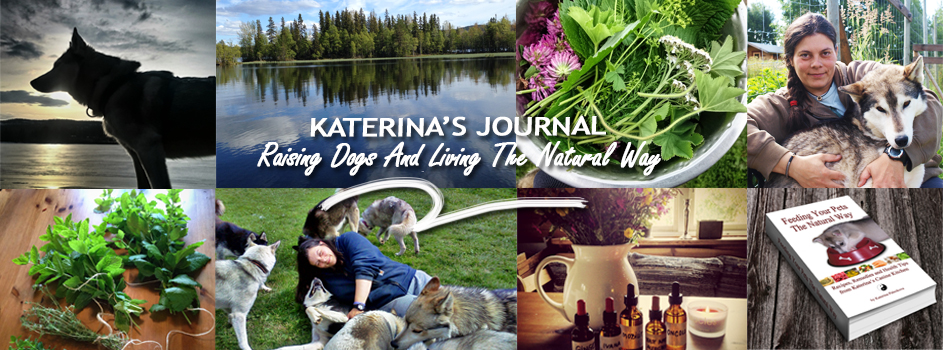
Over the years of living with my large pack of huskies and raising them naturally, I have learned how the shedding process effects the dogs and how to best support them so that they stay in good condition as well as change the coat as quickly and efficiently as possible, and of course grow a new healthy coat.
Shedding is of course a natural process for most dog breeds, and sled dogs are a great example of the importance of growing a nice, healthy, functional coat, especially since they work and are usually out in the elements most of the time. Their healthy coat will protect them against even an extreme cold, prevent them from getting soken wet by the special oily characteristics of the cover (or aka guard) hairs and even insulate them to a certain extend from the summer heat.
Most huskies and other sled dog breeds, but also other working dogs and thick coated breeds will shed twice a year, with the winter coat being naturally thicker and fluffier.
The shedding process has quite a demand on the dog´s body, and over the years with huskies I have learned two major aspects: one is obviously the fact that once the dog looses their coat, the protection against the element (especially the cold) is gone and your dog, especially when living outdoors will use a lot more energy to keep warm.
The second aspect is that growing of the new coat requires a lot of protein and takes a lot of energy and if this elevated demand isn´t adequately met, the dog will loose some of their muscle mass and fat reserves and thus weight.
So I have created a protocol for an all-natural and simple support for our dogs during their shedding season and it works great for all our huskies of all ages and activity levels.
Here are my tips for making the shedding season uncomplicated and the process of changing the coat as quick and efficient as possible, without putting an extra strain on your dog:
This isn´t about esthetics. Not only is it practical to not have piles of hair in literally every corner of the kennel, on our clothes, in the dogs´ water buckets, creeping into your house (because you constantly carry it in your clothes), etc., but there will be less dust and dirt hiding in those piles of hair, making it definitely more hygienic.
But first and foremost it is about giving space for the new coat to grow, and before that happends, to let the air in, and prevent formation of hot spots, eczema etc.
2. Add high quality source of animal protein to your dog´s diet
Increasing the amount of high quality meat will help to meet the elevated need for protein and prevent weight and muscle loss in your dog, and help grow new coat faster, and of better quality.
Whole raw egg (3x per week)
Fish (especially wild caught trout and salmon types of fish or sardines in simple brine in can)
Chicken meat
High quality ready meat mixes for BARF diets such as MUSH - can be either fed complete or as an addition to your existing feeding program, as an additional high quality protein source.
3. High quality Omega 3 and MCT (middle chain triglycerate) sources
This basically means supplementing with oils and fats rich in these essential fatty acids.
At our kennel quality and affordability are two important factors, and I believe this to be the case for many kennels and households with larger dog packs.
We use Flax Seed (fresh ground into a powder or cooked) with great results for a number of years. It is simple to prepare, highly effective and inexpensive.
The dosage of freshly ground flax seed is 1 tea spoon per 10kg (9lbs) of body weight per day.
By feeding fish, we not only provide quality protein but also good source of the fatty acids.
The dosage of freshly ground flax seed is 1 tea spoon per 10kg (9lbs) of body weight per day.
By feeding fish, we not only provide quality protein but also good source of the fatty acids.
I do not recommend most ready fish oils and seed oils because of their nature to oxidize and go rancid. But if you do use one, choose always from wild-caught fish or krill oil.
4. Kelp
Kelp (Ascophyllum nodosum) is a brown sea weed, and the one we use for many years all year round is an organically sourced one from Island.
Kelp is the natural source of many vitamins, minerals and antioxidants, as well as 19 amino acids, making it a perfect supplement for year-round feeding, not just for general support of your dog´s health, but also during times of increased nutrient and micronutrient needs.
Kelp (Ascophyllum nodosum) is a brown sea weed, and the one we use for many years all year round is an organically sourced one from Island.
Kelp is the natural source of many vitamins, minerals and antioxidants, as well as 19 amino acids, making it a perfect supplement for year-round feeding, not just for general support of your dog´s health, but also during times of increased nutrient and micronutrient needs.
I recommend feeding 1 tea spoon dried powdered kelp per 10kg (9lbs) of your dog´s weight once a day, in times of higher need 2x per day.
I have mentioned this across my blog a lot - if there is only one supplement you could or would add to your dog´s diet, I highly recommend it to be Islandic kelp.
If you find these and my other natural dog care tips useful, subscribe to my newsletter to not miss the next post, and feel free to share on your social media to reach more people who may also find it helpful.
Happy shedding season! :)








No comments:
Post a Comment